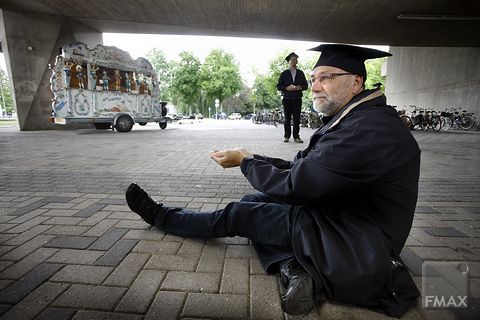‘If I were a rich man’ draaide dit orgel er bij de opening van het collegejaar op los. De vakbonden vroegen daarmee aandacht voor de stukgelopen cao-onderhandelingen.
De bonden willen een salarisverhoging van 1,25 procent om koopkracht te behouden, maar de VSNU zegt daarvoor geen geld te hebben.
Floris van der Ziel recently graduated at the faculty of Civil Engineering and Geosciences (CEG) on an original concept for a ‘movable water barrier for the 21st century’. He likes to call his concept the ‘parachute dam’, because, like a parachute, his weir is a construct that is held in place by ropes and stops the flow of water.
Imagine a wide, horizontally curved bridge that spans a river, as if following a bend in the road. The steel deck is suspended by a series of Dyneema ropes onto two reclining pillars positioned at the inside of the curve. Under this construction, the river flows unimpeded and ship traffic passes unhindered. Except, that is, in cases of emergency, when forecasted high river water levels must be stopped to protect the cities downstream. At such times, the parachute dam will come to the rescue. Hydraulic jacks will start lowering a giant screen from under the bridge into the whirling water below. The force of the water will press the bottom of this heavy rubber screen tightly onto the riverbed. The other end of this rubberised fabric is held upright by dozens of cables attached to the bridge deck, some ten meters higher up. The water level at the inner side of the dam can rise to 4.5 meters higher than downstream. The strongest forces retaining the hydraulic load run along the fabric through a cable located at the bottom of the screen, which is secured to heavy cement foundations situated on the riverbanks. Van der Ziel based his calculations on a 210 meter dam across the Merwede, and concluded that cables made of four, 200 mm Dyneema ropes should be strong enough to cope with the 8,000 tonnes of hydraulic load.
The parachute dam is Van der Ziel’s proposal for the four movable river barriers in water management plan for the water system around Rotterdam and Dordrecht. This ‘Usually Open, Occasionally Closed’ (UOOC) (or Afsluitbare Open Rijnmond) plan aims to provide maximal accessibility to the harbour, while safeguarding this densely populated area from flooding by either the sea from the west or the rivers Rhine and Meuse from the east. The OUOC plan calls for river barriers at Spui, Drecht, Merwede and Lexmond that can be deployed when needed, but which will have to remain in an unobtrusive, resting position most of the time.
Van der Ziel regards concrete and steel weirs as so 20th century. His flexible solution offers many advantages, not least of all that it can be constructed quickly, which is important on a busy waterway. When not in use, the screen is folded under the bridge, so that shipping is not hindered. The (cycle) bridge is an ‘extra’ that stimulates local recreation. The costs are 34 million euro for the bridge and 190 million for the screen, which is about a third cheaper than a steel, movable barrier, Van der Ziel says. What’s more, the screen is not only physically flexible, but it is also adaptable to a changing climate. When in some thirty years time the screen must be replaced, its size can be optimised according to the current conditions.
What then are the chances of one day seeing parachute dams spanning broad Dutch rivers? The idea has been presented previously, in the late 1980s, by professor Han Vrijling, under the name ‘spinnaker dam’, although it was never built, because people feared the screen might fail, allowing the waters to pass over it. Van der Ziel has modified Vrijling’s screen by adding a bridge that will hold the screen in place using dozens of ropes. Still, his supervisor, Ad van der Toorn, doesn’t expect the parachute dam to be constructed on a large scale any time soon. It will first have to be demonstrated as a weir in smaller rivers, he says. There are dozens of suitable locations to construct a parachute dam, but the initiative will have to come from one of the regional water boards. Contractors moreover act conservatively, since most projects nowadays are tendered in design, build & maintenance contracts, which stifles innovation.
Floris van der Ziel was the first CEG student to graduate under the Climate Adaptation Lab (CAL), a joint graduation project of the faculties of CEG and Architecture.



Comments are closed.